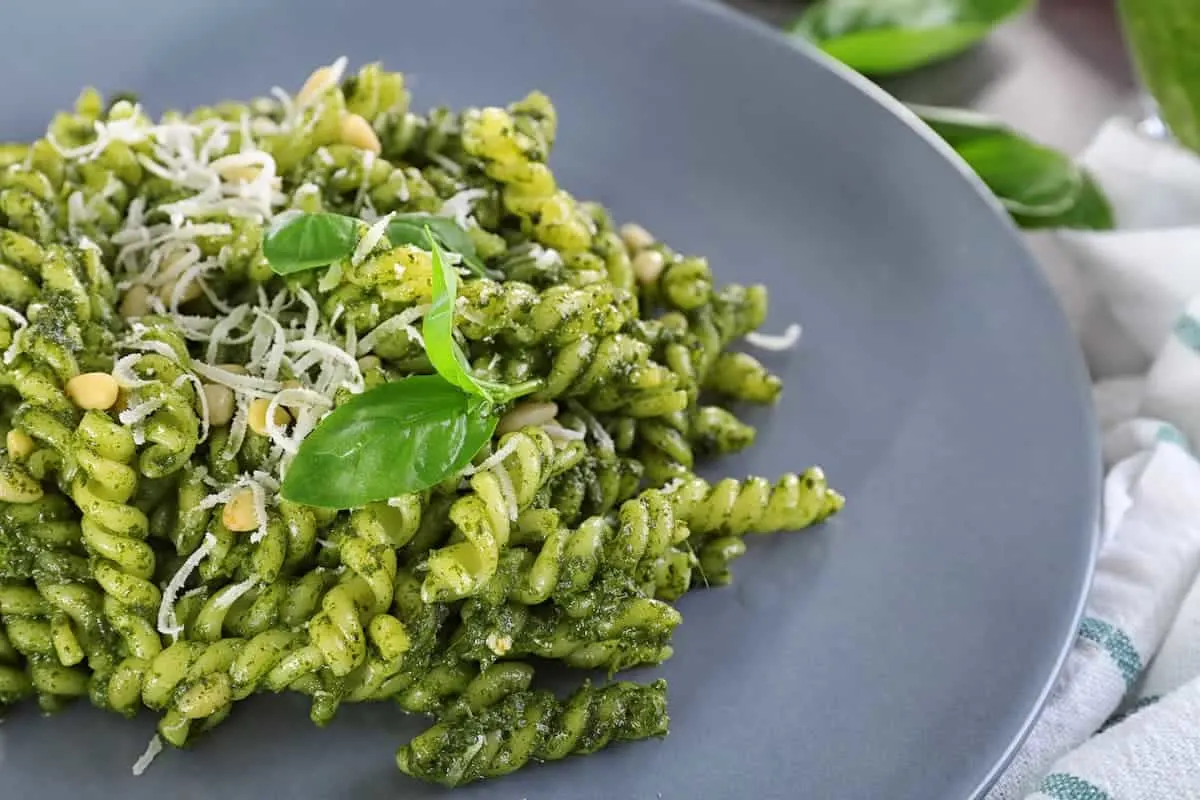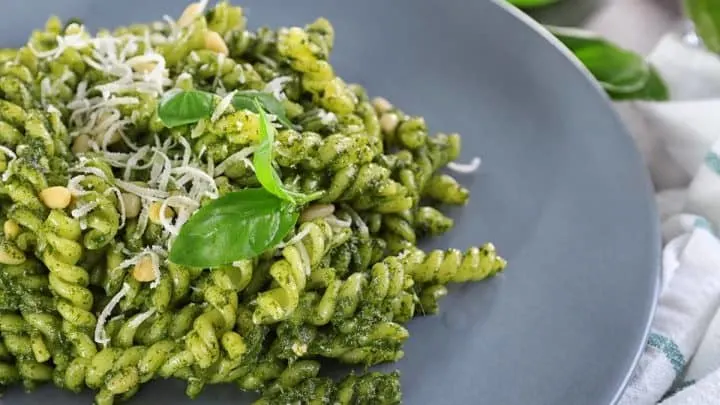It’s quite common for cats to hover over your food as you eat, especially if it’s a tasty pasta dish like pesto. Pesto contains a ton of ingredients though, and it can be tempting to give your cat a taste. What’s the harm right? However, pesto might be more harmful to your cat than you realize. So, can cats eat pesto?
Cats cannot eat pesto. Pesto contains spices, olive oil, milk, and cheeses which can cause cats to vomit and experience cramps. Pesto contains large amounts of garlic which is toxic to cats.
Even a small taste of pesto can be detrimental to your cat’s health. Much of this is due to the high garlic content. We’ll dive into how each of these ingredients can hurt your cat and why you should think twice about letting them try any sort of pesto.

Is Pesto Safe For Cats
Pesto is not safe for cats.
The biggest issue with pesto is what’s in the sauce. Some of the ingredients are bad for cats even in small amounts. Most pesto sauces contain high amounts of sodium and garlic.
Not only can your cat suffer from the toxicity that the garlic causes, but it can also deal with salt poisoning issues on top of it.
What Is Pesto Made Of
There are plenty of ways to make pesto sauce. However, there are a few staple ingredients that you’ll find in most pesto. It’s a good idea to break down the ingredients in pesto and identify which ones are toxic to cats and which ones aren’t.
Below is a list of ingredients in pesto sauce:
| Ingredients In Pesto | Is It Harmful To Cats (Yes/No) |
|---|---|
| Garlic | Yes |
| Cheese | Yes |
| Basil | No |
| Pine Nut | No |
| Olive Oil | No |

While most of the ingredients in pesto aren’t harmful in cats, the two primary ones, garlic and cheese make it dangerous. Here’s a breakdown of both of those ingredients and why have such a negative impact on a cat’s health.
Garlic
The main ingredient in pesto is garlic. Without it, the sauce loses a lot of its great flavor combination. Unfortunately, garlic as a whole is toxic to cats. Whether they eat the whole thing or just a clove, it can cause serious health issues.
Garlic is about five times more toxic than onions when it comes to cats. It’s heavily concentrated and has higher levels of toxic compounds.
So what exactly does garlic do to cats? Well, garlic contains compounds known as disulfide and thiosulphate. Those compounds are found in foods from the Allium family (think chives, onions, shallots, leeks, etc).
Those are compounds that cats cannot digest and it’s where the toxicity comes from.
When a cat eats garlic it can suffer from the following symptoms:
- Red blood cell damage
- Heinz body anemia
- Hemolytic anemia
As you can see, all of these are affecting the blood cells in your cat. That’s a dangerous situation. In fact, garlic can mess with the overall circulation of blood cells in cats. Those compounds cause the cells to lose strength, become incredibly fragile, and in many cases, burst.
When a cat has garlic poisoning as a result of eating pesto sauce, these are the symptoms you’ll likely see:
- rapid breathing
- lethargy
- elevated heart rate
- vomiting
- discolored gums
- diarrhea
Most symptoms occur within a day, but it depends on how much they consume. If a cat were to consume an entire bowl of pesto, you can expect the symptoms to be within a few hours. If your pet starts to develop anemia, you probably won’t notice this for several days; sometimes up to a week later.
Point being made, if your cat eats pesto loaded with garlic, you should take them to the vet immediately to get them checked out.
Cats who lick garlic or have a nibble of it are nothing to panic about. But, the amount they are allotted to have without being poisoned is incredibly low. Typically half a percent of your pet’s body weight is what’s allotted for foods in the Allium family. It’s even less than 0.5% when it comes to garlic though because it’s a more concentrated ingredient.
Cheese
Pesto contains lots of cheese. In most cases, it’s parmesan cheese.
Now, cats can actually have some cheese, but large amounts are not good. Cheese is made with milk and most cats are lactose intolerant. It’s dairy and something that’s not naturally part of your cat’s diet.
A large amount of cheese can disrupt your cat’s digestive system as a whole. The symptoms are pretty clear too and include vomiting and diarrhea.
While cheese isn’t good for cats, it’s not toxic to them.
What Happens If My Cat Eats Pesto
Your cat will become very sick if they eat pesto in large amounts. Because of the ingredients in pesto such as garlic and cheese, they will likely suffer from digestive issues and vomiting.
Depending on how much pesto your cat eats has an impact on the severity. For example, if they were to eat an entire bowl of pesto then you’ll want to be on the lookout for severe health issues. Most of that is due to what issues the garlic will cause.
Pesto contains a lot of spices and is also high in sodium. While most of the spices such as basil won’t have a terrible impact on your cat, the salt itself can.
Cats can have salt, but too much salt can actually lead to salt poisoning. Examples of salt poisoning in cats include dehydration and abnormal fluid accumulation. Your cat will also vomit and have difficulty walking.
The other ingredients in pesto such as olive oil and pine nuts are not harmful to cats. Olive oil has some benefits to cats such as contributing to a shinier coat. It’s also something some pet owners use to curb hairballs in cats. Oil is still fat though, and cats can only eat it in moderation.
Pine nuts are not toxic to cats either, and many pesto recipes include them. Like the other ingredients, they must be eaten in moderation.
Cats can only digest a certain amount of fat. Pine nuts contain fat, so it’s important they don’t consume too much. Each cat is different and some can have allergies to nuts. Cats who suffer from this allergy might end up with anaphylaxis.
What To Do If Your Cat Eats Pesto
If your cat eats or licks pesto sauce there are a few steps you should take. The first step is to remove the pesto dish and observe how much was eaten. Next, monitor your cat for any signs of lethargy, weakness, sickness, vomiting, or other unusual behaviors.
It’s important to remember that most of these problems will not reveal themselves for several hours up to days later. If you are unsure and want to be on the safe side, take your cat to the vet immediately. Vets will be able to run tests to see if your cat is suffering from any salt or garlic poisoning related to the pesto.
As a general rule, the most proactive thing you can do is to prevent your cat from eating pesto in the first place.
Make sure all pesto jars are tightly closed and stored in an area that your cat cannot access. Also, be sure to keep dishes clean and not left out for your cat to lick.

My name is James, and welcome to FAQCats!
Along with our team of cat owners, expert pet enthusiasts, and pet professionals, we aim to write engaging helpful, engaging content about cats. At FAQCats we strive to provide content that’s accurate and fun to read. Our team writes about everything related to cats; even the most complex of topics. Through extensive research and caring for our own fur-pals, we’re able to provide something cat owners worldwide will love. Have a look around, and leave us feedback anytime!

